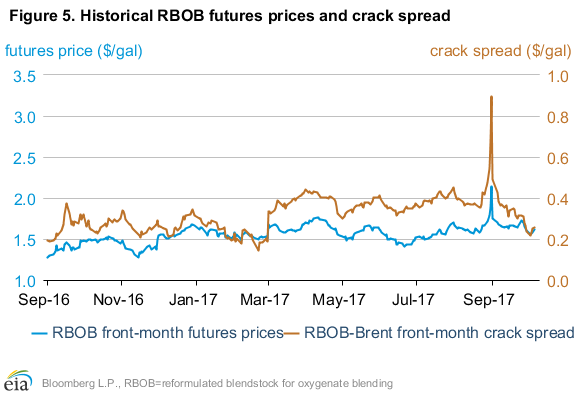
EIA: October Short-Term Energy Outlook
Gasoline prices: The front-month futures price of reformulated blendstock for oxygenate blending (RBOB, the petroleum component of gasoline used in many parts of the country) declined by 14 cents per gallon (gal) from September 1 to settle at $1.61/gal on October 5 (Figure 5). The RBOB-Brent crack spread (the difference between the price of RBOB and the price of Brent crude oil) declined by 24 cents/gal over the same period, settling at 25 cents/gal. EIA compares RBOB prices to Brent prices because EIA research indicates U.S. gasoline prices usually move with Brent prices, the international crude oil benchmark.
As the effects from Hurricane Harvey on gasoline production and transportation began to subside in September, gasoline prices and crack spreads declined. Only one refinery on the U.S. Gulf Coast remained offline as of October 4. No refineries were affected by Hurricane Irma, but because of increased evacuation-related demand, tanker truck limitations, and power outages, many retail gasoline stations were out of service. Following the hurricanes, the RBOB-Brent crack spread returned to seasonally lower levels, which typically occurs because winter-grade gasoline is cheaper for refineries to produce. Both U.S. consumption and exports of gasoline in the four weeks ending September 29 were close to their respective levels in September 2016, according to the Petroleum Supply Monthly (PSM).
Ultra-low sulfur diesel prices: The ultra-low sulfur diesel (ULSD) futures price increased by 4 cents/gal from September 1 to settle at $1.79/gal on October 5. On September 25, ULSD prices rose to the highest point since mid-2015. The ULSD-Brent crack spread (the difference between the price of ULSD and the price of Brent crude oil) declined by 6 cents/gal over the same period and settled at 43 cents/gal (Figure 6).
Despite the decline in the ULSD crack spread, which reflected a return to more normal petroleum market operations following Hurricane Harvey, the average ULSD crack spread in September was 47 cents/gal, the highest for that month since 2008. According to the PSM, U.S. distillate exports set their third consecutive monthly record in July at 1.7 million b/d and U.S. distillate consumption in 2017 has generally remained close to or higher than 2016 levels. Increased consumption and exports of distillate indicates increased global economic growth, because distillate is primarily used to power large trucks and rail and is also used in industrial applications. Broad-based expansion in manufacturing PMIs in most countries, along with increased world trade momentum, is likely contributing to increased distillate demand.
ULSD prices typically rise during the winter months, when demand for home heating is highest. From 2005 to 2016, distillate futures prices during September for October delivery were on average 5 cents/gal lower than distillate prices during September for delivery the following January. However, in September 2017, ULSD prices for January delivery were trading lower than those for October delivery because of a backwardated ULSD futures curve (where near-term contract prices are higher than farther-dated ones) and the gradual reduction of seasonality in the U.S. distillate market. In September 2017, the January 2018 ULSD contract was 3 cents/gal lower on average than the October 2017 ULSD contract (Figure 7), the largest deficit since at least 2000.
Distillate stocks in the United States, ARA, and Singapore (whose data combine distillate and jet fuel) were all lower than their respective five-year averages during the last week of September. As noted in EIA’s 2017 Winter Fuels Outlook, temperatures this winter are expected to be colder than last winter, which was warmer than average. The U.S. East Coast, the region of the United States with the most households using heating oil for heating purposes, is expected to be colder than last winter; however, temperatures are forecasted to be near the five-year average. EIA projects U.S. distillate consumption to be 3% higher than last winter, but higher refinery runs this winter are expected to help moderate ULSD prices.
This article is part of Uncategorized
Tagged:
MARKET CONDITION REPORT - DISCLAIMER
The information contained herein is derived from sources believed to be reliable; however, this information is not guaranteed as to its accuracy or completeness. Furthermore, no responsibility is assumed for use of this material and no express or implied warranties or guarantees are made. This material and any view or comment expressed herein are provided for informational purposes only and should not be construed in any way as an inducement or recommendation to buy or sell products, commodity futures or options contracts.








